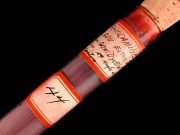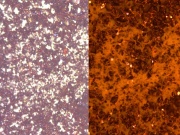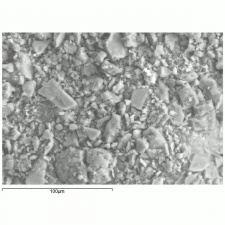Difference between revisions of "Rhodamine B"
| Line 9: | Line 9: | ||
Basic Violet 10; CI 45170; tetraethylrhodamine; D&C Red No. 19, Solvent Red 49; Pigment Violet 1 (phosphotungstomolybdic acid salt); Pigment Red 169 (copper ferrocyanide salt); Pigment Red 173 (aluminum salt); Rhodamine (Deut.); Rodamina B (Esp.); rodamina B (Port.); rhodamine B (Fr.); | Basic Violet 10; CI 45170; tetraethylrhodamine; D&C Red No. 19, Solvent Red 49; Pigment Violet 1 (phosphotungstomolybdic acid salt); Pigment Red 169 (copper ferrocyanide salt); Pigment Red 173 (aluminum salt); Rhodamine (Deut.); Rodamina B (Esp.); rodamina B (Port.); rhodamine B (Fr.); | ||
| − | [[[SliderGallery rightalign|Rhodamine (Forbes MFA 44) copy.tif~ | + | [[[SliderGallery rightalign|Rhodamine (Forbes MFA 44) copy.tif~Raman (MFA)|f44sem.jpg~SEM|f44edsbw.jpg~EDS|rhodamine b.jpg~Chemical structure]]] |
== Other Properties == | == Other Properties == | ||
Revision as of 13:06, 6 November 2019
Description
A strong, bright red Fluorescent dye. Rhodamine B is a Basic dye that was developed in 1887 by Ceresole. It is used as Textile and Paper dye, as a pigment, and as a staining reagent for the detection of fats and oils. Some oil modified materials such as alkyds and urethanes will also stain with rhodamine (Wolbers et al 1990). Rhodamine B has been used as a fluorescent colorant in inks (ballpoint, printing), wood stains, Distemper paints, and shoe polish.
Synonyms and Related Terms
Basic Violet 10; CI 45170; tetraethylrhodamine; D&C Red No. 19, Solvent Red 49; Pigment Violet 1 (phosphotungstomolybdic acid salt); Pigment Red 169 (copper ferrocyanide salt); Pigment Red 173 (aluminum salt); Rhodamine (Deut.); Rodamina B (Esp.); rodamina B (Port.); rhodamine B (Fr.);
Other Properties
Green crystals or violet powder. Soluble in water, ethanol, polar solvents.
Maximum absorption wavelength = 545 nm.
Maximum emission wavelength = 625 nm.
| Composition | C28H31ClN2O3 |
|---|---|
| CAS | 81-88-9 |
| Melting Point | 210-211 |
| Molecular Weight | mol. wt. = 478.68 |
Hazards and Safety
Carcinogen. Mutagen.
Mallinckrodt Baker: MSDS
Additional Information
° R. Wolbers, N. Sterman and C. Stavroudis, "Notes for Workshop on New Methods in the Cleaning of Paintings", 1990, GCI, Los Angeles. ° Website for absorption/fluorescent spectra: http://www.omlc.ogi.edu/spectra/PhotochemCAD/html/rhodamineB.html
Additional Images
Sources Checked for Data in Record
- Reed Kay, The Painter's Guide To Studio Methods and Materials, Prentice-Hall, Inc., Englewood Cliffs, NJ, 1983
- Richard S. Lewis, Hawley's Condensed Chemical Dictionary, Van Nostrand Reinhold, New York, 10th ed., 1993
- Richard C. Wolbers, Nanette T. Sterman, Chris Stavroudis, Notes for Workshop on New Methods in the Cleaning of Paintings, J.Paul Getty Trust, Los Angeles, 1990
- Monona Rossol, The Artist's Complete Health and Safety Guide, Allworth Press, New York, 1994
- The Merck Index, Martha Windholz (ed.), Merck Research Labs, Rahway NJ, 10th edition, 1983 Comment: entry 8349
- Website address 1 Comment: www.straw.com/sig/dyehist - discovered 1887
- Aldrich Chemical Catalog Comment: p. 1299
- Colour Index International online at www.colour-index.org






